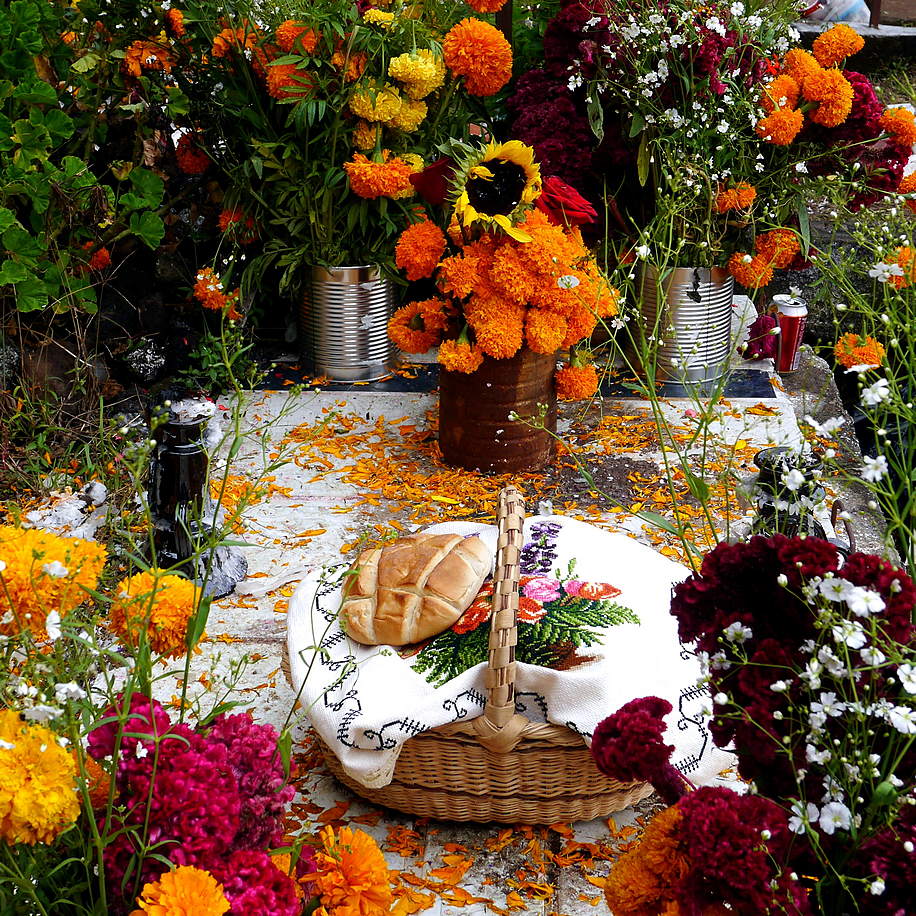We don’t need to be convinced that food plays a central role in people’s lives and cultures that goes way beyond the basic need for sustenance. But if we did need proof, Mexico’s Day of the Dead observances would be Exhibit A.
On November 1, families decorate the graves of their lost loved ones with marigold flowers. It’s a custom, several women told us, that brings them close to their loved ones and makes them feel contento (content). The bright orange flowers almost cover the gravestones and their pungent aroma fills the air. We’ve really never seen anything else quite like it. As we looked more closely, we realized that families also leave personal belongings and mementos that their loved ones had enjoyed in life. We saw many photos from happier days, small toys loved by children lost too young, or even cigars or packs of cigarettes.
But food and drink are by far the most common ofrenda (offering). Judging by the graves we visited, the dead enjoyed rum, tequila, and Diet Coke in almost equal measure. We also found fresh fruits, plates of tortillas, tamales, and enchiladas. The most common—and traditional—offering is pan de muerto, a slightly sweet and aromatic bread shaped in a round loaf and decorated with scraps of dough in a stylized skeleton. Like many traditional foods, pan de muerto has several competing origin stories. One involves human sacrifice and the intervention of Spanish conquerors. But I doubt that Mexicans think much about the back story when they bake their loaves—or, more likely, purchase them in a bakery. They make sure to have enough to share with the dead and to enjoy with the living. Food forms the bond between the two worlds.
Here is a recipe for a simple pan de muerto flavored with an orange glaze. Some recipes also add anise seeds or anise extract to the dough.
PAN DE MUERTO
 Makes 2 loaves, each serving 6-8
Makes 2 loaves, each serving 6-8
INGREDIENTS FOR DOUGH
5 cups all-purpose flour (extra as needed)
1/2 cup sugar
2 packets yeast
1 teaspoon salt
1/2 cup milk
1/2 cup butter
1/2 cup water
4 eggs
INGREDIENTS FOR GLAZE
1/2 cup sugar plus extra for sprinkling
1/3 cup orange juice
2 tablespoons grated orange zest
DIRECTIONS
Place 1 1/2 cups flour, sugar, yeast, and salt into a large bowl. Mix well and set aside.
In a saucepan over medium heat, warm the milk, butter, and water until the butter melts. Pour into the bowl of dry ingredients and mix thoroughly. Add the eggs and mix thoroughly.
Keep mixing as you slowly add the remaining remaining flour. It’s quite hard work once the dough thickens (unless you use an electric mixer). Keep adding the flour until the dough is soft and just slightly sticky.
Transfer the dough to a floured board and knead for 10 minutes until it is smooth and stretchy. Put the dough into a greased bowl, cover with plastic wrap, and allow to rise until double in size. This should take about 90 minutes. (A warm location will help the dough rise more quickly.)
Set oven at 350°F to preheat.
Divide the dough evenly and shape into two rounds, reserving some dough for decorations. Use reserved dough to layer strips on top of the loaves so that they resemble bones.
Place loaves on a baking sheet and bake for 20 to 40 minutes, depending on the size of the loaves and the accuracy of your oven. Check the loaves at regular intervals and remove when they are golden brown.
While the loaves are baking, prepare the glaze. Boil the sugar, orange juice and zest in a saucepan for two minutes. Brush over the loaves while they are still warm and sprinkle with sugar.

